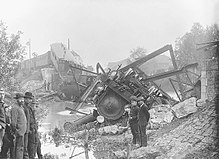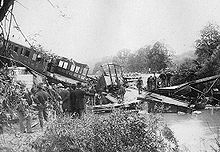Railway accident at Münchenstein
The railway accident in Münchenstein on June 14, 1891 is the largest railway disaster in Switzerland to date .
When a railway bridge over the Birs collapsed near the Bruckgut in Münchenstein (in the Birseck area ) near Basel , 73 passengers died and 171 were injured. One soldier died of injuries sustained during the cleanup. As a result, Swiss railway bridges were systematically examined and the first construction standards were created.
Framework
The bridge
In 1874, the contract for the construction of a single-track railway bridge over the Birs for the Jura line of the Jura-Simplon Railway , a private railway , was awarded to the company of Gustave Eiffel , a young company with which he already had several railway bridges and four larger railway viaducts in France planned and built. The contract with the Jura-Simplon Railway provided for wrought-iron parabolic beams , but allowed Eiffel to make changes in agreement with the railway management.
The bridge that was finally built had parallel - chorded trusses with an underlying carriageway and a span of 42 m and crossed the river at an angle of about 51 °. Their tracks were around 5 m above the water level. Immediately behind the bridge, the railway line curved in a curve with a radius of 350 meters. Therefore, a maximum speed of 30 km / h was permitted here. However, this regulation was no longer considered to exist after the bridge was later strengthened.
Completed and commissioned in 1875, the bridge gave no cause for complaint. However, a flood of the bridged Birs river in 1881 caused the bridge's abutments to sink. The visible damage (e.g. loose and cracked rivets ) was quickly repaired and the bridge was opened again a few days later. The sunken abutment was later corrected. Because of the enormous increase in the weight of the locomotives, reinforcements were added in 1890.
The train
The passenger train that crashed was train number 174 of the Jura Railway , which began its journey in the train station on Centralbahnplatz in Basel. Due to the high number of passengers on the day of the accident, two more passenger coaches were stopped at the last moment and a second heavy locomotive was harnessed. Behind the tender of the second locomotive, the train thus led a baggage car , two passenger carriages, a mail car , an express freight car and eight other mostly four-axle passenger carriages.
In the investigation report on the accident, the number of passengers in the ten cars was estimated at 530 to 550 people.
the accident
The passenger train No. 174 left the station at Centralbahnplatz in Basel on June 14, 1891 at 2:15 p.m. When he drove up to the Münchenstein station at a speed of 41 km / h and braked on the railway bridge immediately in front of it, the structure initially swayed and then collapsed under the load of the forces acting on it and the vibration when the locomotive in front did had just reached the otherworldly abutment.
The front part of the train, the two locomotives, the baggage car, the two subsequently added passenger cars, mail cars, express freight cars and two other passenger carriages crashed into the Birs, which had risen rather high. The two passenger coaches sank immediately into the high waters of the river, one coach got stuck on the abutment on the Basel side and was torn apart in the process.
The last five passenger cars with numerous passengers remained unharmed on the tracks because the clutches and brake lines tore and the air pressure collapsed. This activated the air brakes immediately and brought the rear wagons to a halt before they could fall into the river. Most of the passengers in these cars got away with the horror.
consequences
On the day after the accident, the National Council and the Council of States expressed their condolences to the relatives of the victims in special speeches. On Wednesday, June 17, 1891, five of the victims were buried in the Münchenstein cemetery with great sympathy. The relatives had requested a burial of the dead in the community where the accident happened. The grave site where they found their final resting place was later given a memorial obelisk . The Jura-Simplon-Bahn donated the memorial obelisk and it is a reminder of the railway disaster in Münchenstein to this day. A second such memorial stone is on the village cemetery in Reinach BL .
The first Swiss bridge construction standard was published just one year later. In addition, all railway bridges in Switzerland were checked, and many had to be reinforced.
The Hofmatt Foundation goes back to the railway accident. The wealthy Zaeslin-Staehelin family from Basel then founded a home for surviving dependents and convalescents, the Hofmatt. This became a retirement home at the beginning of the 20th century.
Findings of the investigation and legal proceedings
The Birsh flood in 1881 caused the abutments to sink. The bridge also suffered static damage, which initially went unnoticed. The train, which was led 25% above the maximum permitted speed in the leader, exerted such strong forces on the weakened structure when braking in front of the station due to its weight and the relatively strong braking deceleration that it collapsed under the load. Karl Wilhelm Ritter (1847–1906) and Ludwig von Tetmajer (1850–1905), professors at the Swiss Federal Polytechnic in Zurich , were primarily concerned with the collapse of the Birs Bridge . Their expert opinion showed that the bridge was inadequately constructed for cost reasons even before the flood damage, the iron used predominantly did not have the necessary strength and toughness and at least one abutment was undermined, the reinforcement measures of 1890 had not eliminated the main structural weaknesses, but the move ahead was not derailed from the collapse of the bridge.
In a civil case, the civil court of the canton of Basel-Stadt, which was competent at first instance, agreed with this view and attributed the accident to gross negligence on the part of the operating company. The appellate court of the canton of Basel-Stadt , however, considered the inadequate repair work after the Birs flood in 1881 to be decisive. As the steel girders of the bridge initially buckled due to the flood and were mechanically bent back during the repair, the steel was significantly weakened, so that the bridge collapsed. The Swiss Federal Supreme Court , however, decided in the last instance in favor of the railway company: The lightweight construction of the bridge was just as little responsible for the accident as a lack of construction supervision in the period that followed. Any damage caused by the flood of 1881 was not apparent to those responsible. As a result, the plaintiff only received compensation for her material damage, but not a further compensation amount of CHF 20,000 that had been awarded by the lower courts . After obtaining expert opinions, the responsible public prosecutor's office in Basel-Land decided not to bring charges against the railway accident in 1892 .
Accident of international renown
The accident with over seventy fatalities was not only noticed in Basel and the Basel area . It became a catastrophe of international fame beyond the cantons and national borders. The international press rated the Münchenstein disaster as “the greatest continental railway accident”. At that time there was only one comparable accident in European railway history - the collapse of the bridge over the Firth of Tay (1879).
literature
- Fritz Baur: Basler Chronik from November 1, 1890 to October 31, 1891 . In: Albert Burckhardt and Rudolf Wackernagel (eds.): Basler Jahrbuch 1892 . Verlag von R. Reich, pp. 221-227.
- Ruedi Graf: The railway disaster in Münchenstein, June 14, 1891, attempt at an archeology of the gaze . In: Picture stories - From the picture collection of the State Archives Basel-Stadt 1899–1999. Schwabe & Co AG publishing house. Basel 1999. ISBN 3-7965-1418-9 , pp. 72-75.
- Karl Loeliger: The railway accident at Münchenstein June 14, 1891 . In: Commission for the Preservation of Antiquities of the Canton of Basellandschaft (ed.): Baselbieter Heimatbuch Vol. 4. 1954, pp. 127-139 (with the official death list of the police department).
- Peter Marti, Orlando Monsch and Massimo Laffranchi: Swiss Railway Bridges . Ed .: Society for Civil Engineering. 1st edition. vdf Hochschulverlag AG. Zurich 2001. ISBN 978-3-7281-2786-0 .
- Bernd Nebel: Collapse of the Birs Bridge near Münchenstein (Basel) . (accessed January 2, 2008)
- Ludwig Ritter von Stockert : Railway accidents. A contribution to railway operations theory . Leipzig 1913. Vol. 1., pp. 219ff, no. 123; Vol. 2, Figs. 77 and 78.
- Karl Wilhelm Ritter, Ludwig von Tetmajer: Report on the Mönchenstein bridge disaster: the head of Switzerland. Post and railroad departments reimbursed. In: Schweizerische Bauzeitung , Volume 18, Issue 26, December 26, 1891, Appendix pp. 1–18 (PDF)
- Conrad Zschokke and Leonhard Seifert: Expert opinion on the causes of the collapse of the Mönchensteiner railway bridge (June 14, 1891) - commissioned by the President of the Civil Court of Basel . Birkhäuser book printing company, Basel, 1891.
Web links
- Collapse of the Birs Bridge near Münchenstein
- Basel Chronicle on June 14, 1891
- The Münchenstein railway disaster in 1891
Individual evidence
- ↑ Railway accident 1891 on muenchenstein.ch ( page no longer available , search in web archives ) Info: The link was automatically marked as defective. Please check the link according to the instructions and then remove this notice.
- ↑ "The screaming, groaning and moaning of the wounded sounded horrific" In: Neue Zürcher Zeitung of June 8, 2020
- ↑ Railway disaster in Münchenstein 1891 on altbasel.ch
- ^ Société de constructions de Levallois-Perret, later also Eiffel et Comp.
- ↑ Stockert, p. 220.
- ↑ a b The judicial decisions in the matter of the Möchenstein bridge disaster. In: Schweizerische Bauzeitung , Volume 20, Issue 13, 1892, pp. 83–86
- ^ A b c Karl Wilhelm Ritter, Ludwig von Tetmajer: Report on the Mönchensteiner bridge disaster: the head of Switzerland. Post and railroad departments reimbursed. In: Schweizerische Bauzeitung , Volume 18, Issue 26, December 26, 1891, Appendix pp. 1–18 (PDF)
- ^ Stockert, p. 219.
- ↑ Railway accident in Münchenstein 1891 on photobibliothek.ch
- ↑ Stockert, p. 220.
- ↑ Stockert, p. 220, states that the first seven wagons of the train crashed into the river.
- ↑ Hofmatt Retirement and Nursing Home / Mission Statement (PDF; 210 kB) Hofmatt Foundation Council. 2005. Archived from the original on December 2, 2013. Info: The archive link was automatically inserted and has not yet been checked. Please check the original and archive link according to the instructions and then remove this notice. Retrieved November 16, 2010.
- ↑ Published in: Zentralblatt der Bauverwaltung 1891, p. 473.
- ↑ BGE 19 I, pp. 185-220. A detailed legal opinion by the Bonn legal scholar Julius Baron on the civil law problems of the case can be found in: Archiv für die civilistische Praxis 31 (1893), pp. 177–261





